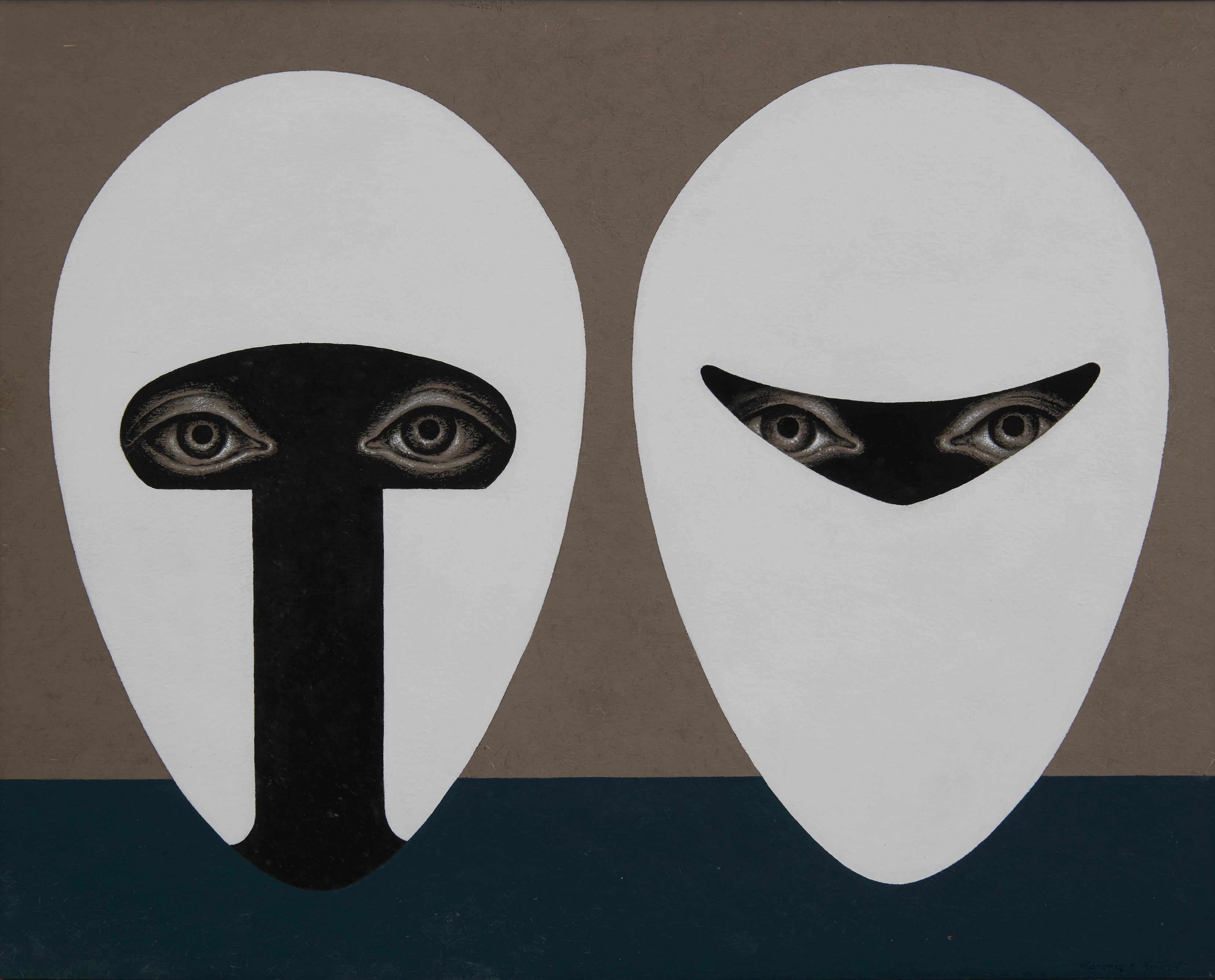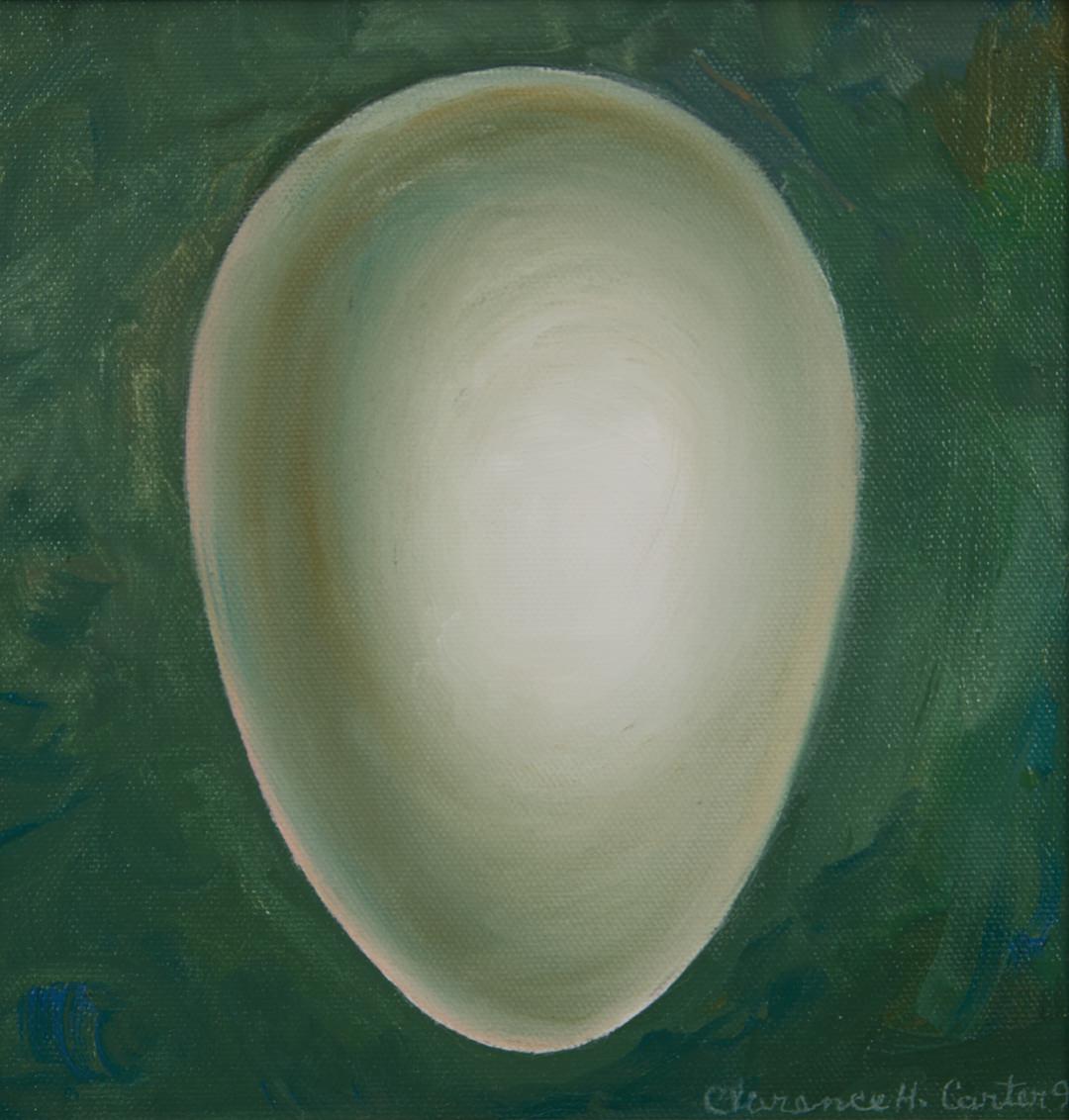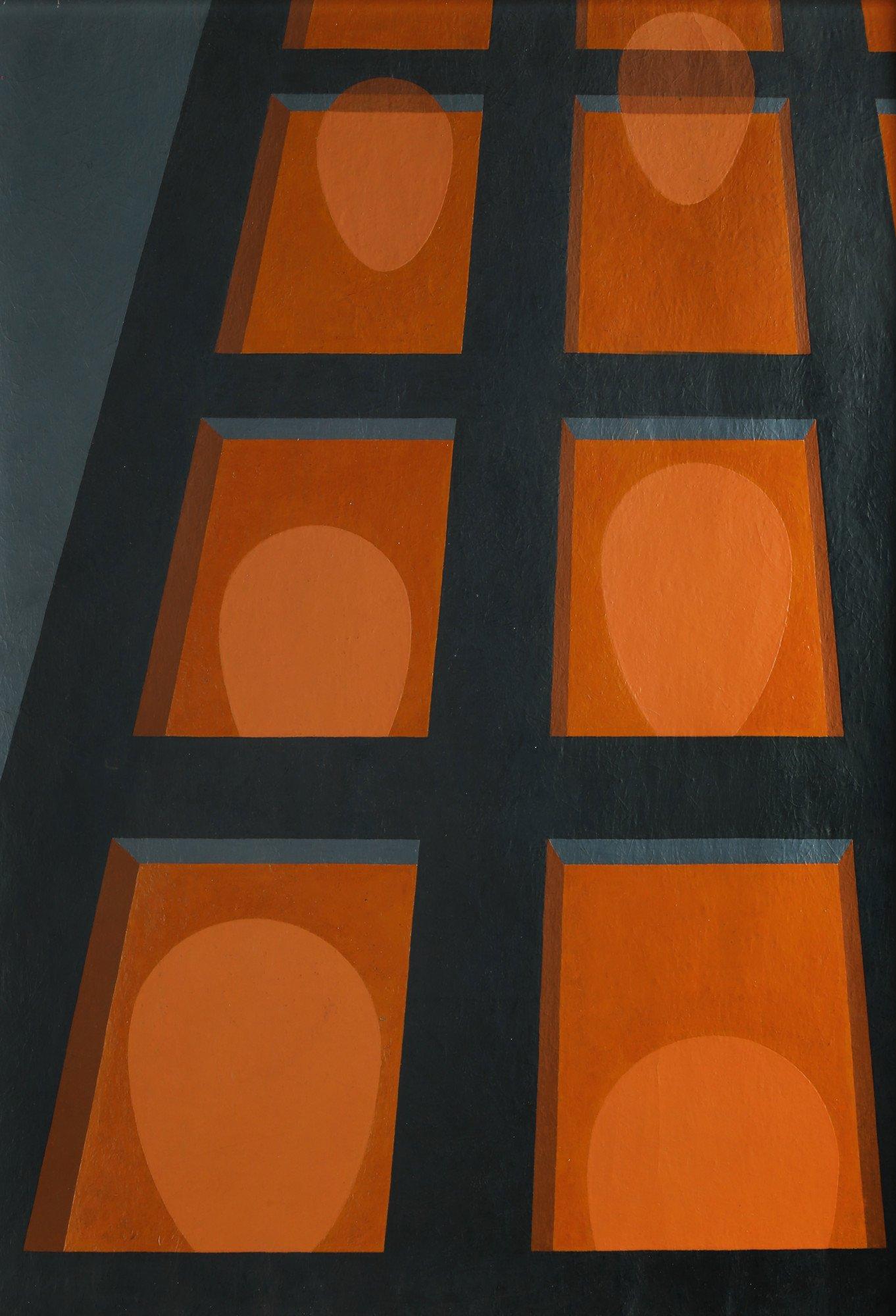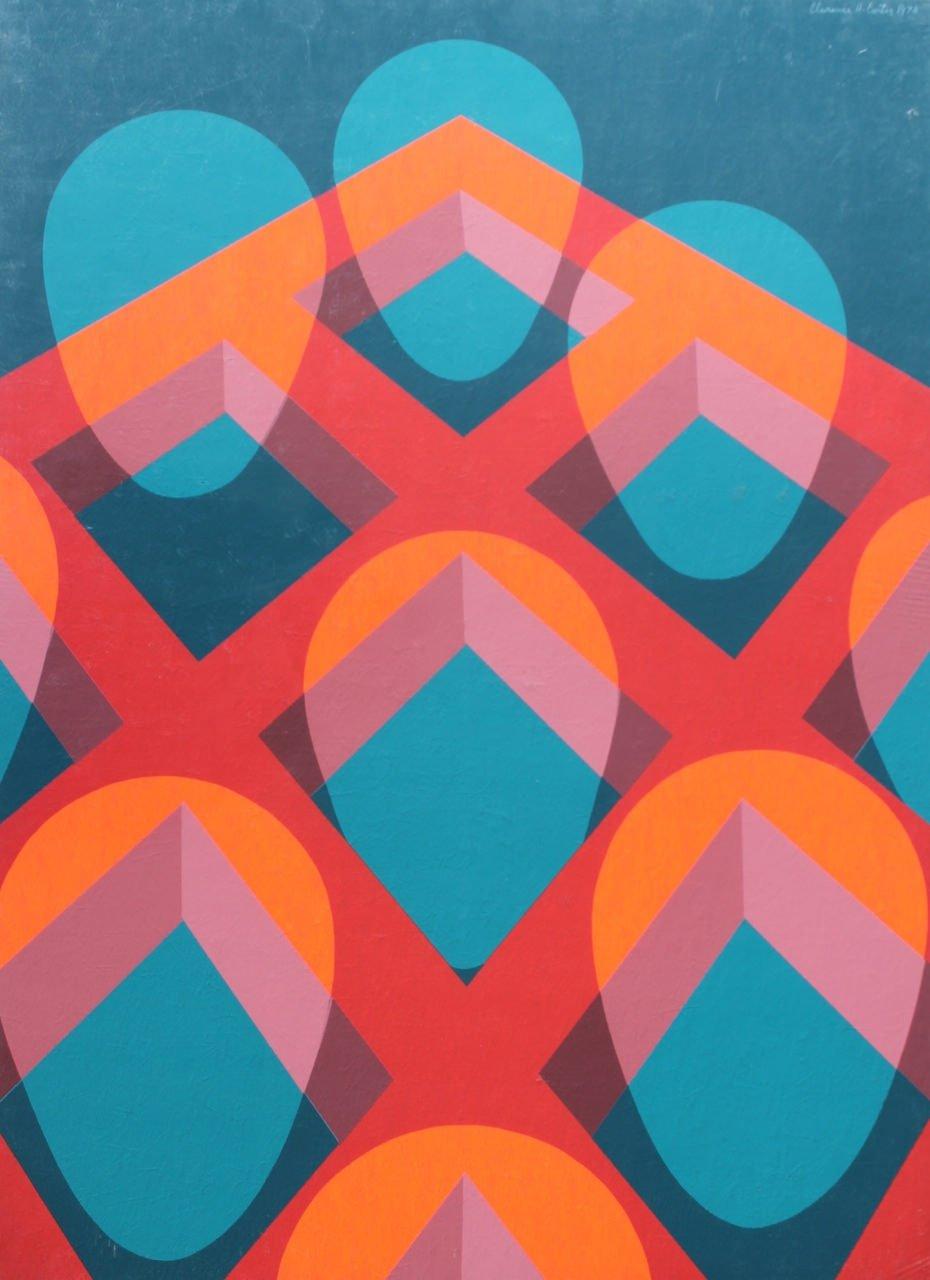Items Similar to Quadratic, Mid-Century Ovoid Figural Abstract Acrylic & Collage with faces
Want more images or videos?
Request additional images or videos from the seller
1 of 9
Clarence Holbrook CarterQuadratic, Mid-Century Ovoid Figural Abstract Acrylic & Collage with faces1979
1979
About the Item
Clarence Holbrook Carter (American, 1904-2000)
Quadratic, 1979
Acrylic and collage on textured paper
Signed and dated lower right
30 x 22 inches
31.5 x 23.5 inches, framed
A surrealist mid-century figural abstract painting.
Clarence Holbrook Carter achieved a level of national artistic success that was nearly unprecedented among Cleveland School artists of his day, with representation by major New York dealers, scores of awards and solo exhibits, and streams of praise flowing from pens of the top art critics. Over the course of his 60+ year career Carter evolved from an exceptionally fine American Scene painter capable of evoking deep reservoirs of mood, into an abstractionist with a strongly surrealist bent.
Carter's quest for a symbolic artistic language continued in this period with the introduction for the Ovoid or Egg form into his work. Perfectly suited to his preoccupation with the mysteries of life and the themes of death and transfiguration, the Ovoid or Egg symbolized all of these mysteries in a succinct and visually simple form. The Ovoid/Egg is employed in various fashions to wonderful effect by Carter. It is at once tough and fragile, and in Carter's depictions it is opaque or translucent; it is reminiscent of the shape of a human head, it becomes a substitute for a person or a soul. The Egg/Ovoid that is devoid of human features is given a single eye, or mouth, and is an instantly recognizable reduction of the human being.
- Creator:Clarence Holbrook Carter (1904-2000, American)
- Creation Year:1979
- Dimensions:Height: 31.5 in (80.01 cm)Width: 23.5 in (59.69 cm)
- Medium:
- Movement & Style:
- Period:
- Condition:
- Gallery Location:Beachwood, OH
- Reference Number:1stDibs: LU1768211317702
About the Seller
No Reviews Yet
Vetted Seller
These experienced sellers undergo a comprehensive evaluation by our team of in-house experts.
Established in 1975
1stDibs seller since 2022
9 sales on 1stDibs
Typical response time: <1 hour
- ShippingRetrieving quote...Ships From: Beachwood, OH
- Return PolicyA return for this item may be initiated within 14 days of delivery.
More From This SellerView All
- Medieval Heads, mid-century figural surrealist acrylic paintingBy Clarence Holbrook CarterLocated in Beachwood, OHClarence Holbrook Carter (American, 1904-2000) Cicada, c. 1960s Watercolor on scintilla 30 x 20 inches Clarence Holbrook Carter achieved a level of national artistic success that wa...Category
1960s American Modern Figurative Paintings
MaterialsAcrylic
- Ovoid, geometrical figural surrealist acrylic painting, Cleveland School artistBy Clarence Holbrook CarterLocated in Beachwood, OHClarence Holbrook Carter (American, 1904-2000) Ovoid, 1992 Acrylic on canvas Signed and dated lower right 7.75 x 7.75 inches 9 x 9 inches, framed Clarence Holbrook Carter achieved a...Category
1990s American Modern Abstract Paintings
MaterialsAcrylic
- Transection w/ Architectural Forms, Geometrical Figurative Abstract AcrylicBy Clarence Holbrook CarterLocated in Beachwood, OHClarence Holbrook Carter (American, 1904-2000) Transection with Architectural Forms, c. 1980s Acrylic and graphite on board 12 x 20 inches A surrealist mid-century figural abstract ...Category
1980s American Modern Abstract Paintings
MaterialsAcrylic, Graphite
- In the Window, Ovoid Shapes Floating Through WindowsBy Clarence Holbrook CarterLocated in Beachwood, OHClarence Holbrook Carter (American, 1904-2000) In the Window, 1973 Acrylic and collage on scintilla Signed and dated lower right 30 x 22 inches A surrealist mid-century figural abs...Category
1970s American Modern Abstract Paintings
MaterialsAcrylic
- Transection No. 3, Ovoid Geometrical Figural Abstract Neon Acrylic PaintingBy Clarence Holbrook CarterLocated in Beachwood, OHClarence Holbrook Carter (American, 1904-2000) Transection No. 3, 1972 Acrylic on paper Signed and dated upper right 30 x 22 inches Provenance: Collection of William H. Milliken Cl...Category
1970s American Modern Abstract Paintings
MaterialsAcrylic
- Seeing Egg No. 2, Surrealist Ovoid acrylic painting, Figural AbstractBy Clarence Holbrook CarterLocated in Beachwood, OHClarence Holbrook Carter (American, 1904-2000) Seeing Egg No. 2, 1965 Acrylic and collage on scintilla Signed and dated upper right 30 x 22 inches 34 x 29 inches, framed A surrealis...Category
1960s American Modern Abstract Paintings
MaterialsAcrylic
You May Also Like
- R.E.M. - Murmur (Grammy, Album Art, Iconic, Rock and Roll, Pop, Legendary)By Kerry SmithLocated in Kansas City, MOKerry Smith R.E.M. - Murmur Mixed Media on Crescent board Year: 2022 Size: 21x20in Signed, dated by hand COA provided Ref.: 924802-1633 --------------------------------------- "Of...Category
2010s American Modern Figurative Paintings
MaterialsAcrylic, Gouache, Board, Mixed Media
- Johnny Hodges - The Big Sound (Grammy, Album Art, Iconic, Rock and Roll, Pop)By Kerry SmithLocated in Kansas City, MOKerry Smith Johnny Hodges - The Big Sound Mixed Media on Crescent board Year: 2016 Size: 21x20in Signed, dated by hand COA provided Ref.: 91-0194 ----------------------------------...Category
2010s American Modern Figurative Paintings
MaterialsMixed Media, Acrylic, Gouache, Board
- Untitled Figurative Abstract PaintingBy Brendan McKeonLocated in Houston, TXUntitled red figurative abstract painting with various nude figures holding various objects by Portland, Oregon artist Brendan McKeon. The canvas is not currently framed.Category
Late 20th Century American Modern Figurative Paintings
MaterialsAcrylic
- Golfer Swinging, Vintage 7 Up Ad "Get Real Action" in Green and Yellow - GolfBy Bob PeakLocated in Miami, FLThis strobe-like dynamic composition with bright and bold colors reflects the energetic taste of the 7 Up brand. It lies somewhere between abstraction and figuration. Peaks' use of b...Category
1960s American Modern Figurative Paintings
MaterialsAcrylic, Illustration Board
- Led Zeppelin - Houses Of The Holy (Grammy, Album Art, Iconic, Rock and Roll)By Kerry SmithLocated in Kansas City, MOKerry Smith Led Zeppelin - Houses Of The Holy Mixed Media on Crescent board Year: 2018 Size: 21x20in Signed, dated by hand COA provided Ref.: 924802-1632 --------------------------...Category
2010s American Modern Figurative Paintings
MaterialsMixed Media, Acrylic, Gouache, Board
- The Magician oil and tempera painting by Julio de DiegoBy Julio de DiegoLocated in Hudson, NYJulio De Diego’s Atomic Series paintings made an extraordinary statement regarding the shock and fear that accompanied the dawn of the nuclear age. In the artist’s own words, “Scientists were working secretly to develop formidable powers taken from the mysterious depths of the earth - with the power to make the earth useless! Then, the EXPLOSION! . . . we entered the Atomic Age, and from there the neo-Atomic war begins. Explosions fell everywhere and man kept on fighting, discovering he could fight without flesh.” To execute these works, De Diego developed a technique of using tempera underpainting before applying layer upon layer of pigmented oil glazes. The result is paintings with surfaces which were described as “bonelike” in quality. The forms seem to float freely, creating a three-dimensional visual effect. In the 1954 book The Modern Renaissance in American Art, author Ralph Pearson summarizes the series as “a fantastic interpretation of a weighty theme. Perhaps it is well to let fantasy and irony appear to lighten the devastating impact. By inverse action, they may in fact increase its weight.” Exhibited 1964 Marion Koogler McNay Art Institute, San Antonio, Texas This work retains its original frame which measures 54" x 42" x 2" About this artist: Julio De Diego crafted a formidable persona within the artistic developments and political struggles of his time. The artist characterized his own work as “lyrical,” explaining, “through the years, the surrealists, the social-conscious painters and the others tried to adopt me, but I went my own way, good, bad or indifferent.” [1] His independence manifested early in life when de Diego left his parent’s home in Madrid, Spain, in adolescence following his father’s attempts to curtail his artistic aspirations. At the age of fifteen he held his first exhibition, set up within a gambling casino. He managed to acquire an apprenticeship in a studio producing scenery for Madrid’s operas, but moved from behind the curtains to the stage, trying his hand at acting and performing as an extra in the Ballet Russes’ Petrouchka with Nijinsky. He spent several years in the Spanish army, including a six-month stretch in the Rif War of 1920 in Northern Africa. His artistic career pushed ahead as he set off for Paris and became familiar with modernism’s forays into abstraction, surrealism, and cubism. The artist arrived in the U.S. in 1924 and settled in Chicago two years later. He established himself with a commission for the decoration of two chapels in St. Gregory’s Church. He also worked in fashion illustration, designed magazine covers and developed a popular laundry bag for the Hotel Sherman. De Diego began exhibiting through the Art Institute of Chicago in 1929, and participated in the annual Chicago Artists Exhibitions, Annual American Exhibitions, and International Water Color Exhibitions. He held a solo exhibition at the Art Institute of Chicago in the summer of 1935. Though the artist’s career was advancing, his family life had deteriorated. In 1932 his first marriage dissolved, and the couple’s young daughter Kiriki was sent to live with friend Paul Hoffman. De Diego continued to develop his artistic vocabulary with a growing interest in Mexican art. He traveled throughout the country acquainting himself with the works of muralists such as Carlos Merida, and also began a collection of small native artifacts...Category
1940s American Modern Abstract Paintings
MaterialsMasonite, Oil, Tempera
Recently Viewed
View AllMore Ways To Browse
Figural Abstract
Mid Century Figure
Abstract Painting With Figure
Acrylic Collage
Mid Century Face
Modern Art With Face
New York Dealers
Abstract Face Art
Abstract Face Painting
Period Face
Painting Of Abstract Face
Acrylic Mid Century Paintings
Modern Face Paintings
Vintage Face Painting
Mid Century Figural Painting
Mid Century Figure Painting
Midcentury Acrylic Painting
Mid Century Modern Art Figure





